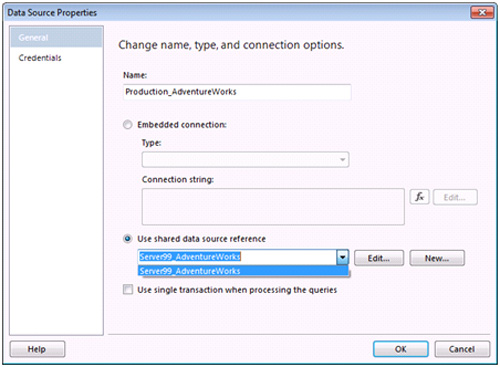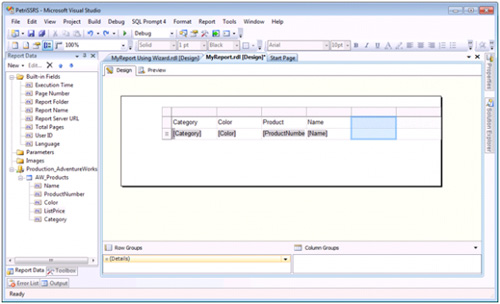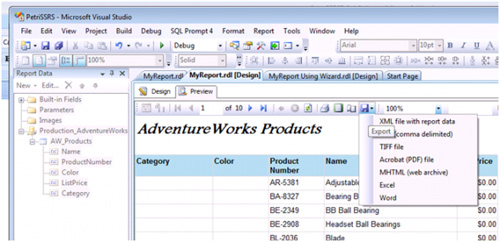Instructions for creating and editing reports in SQL Server Reporting Services
QuanTriMang.com - The set of SQL Server 2005, 2008 and 2008 R2 products, all packaged with SQL Server Reporting Services (SSRS) - a specialized solution for creating reports for businesses. With SSRS, users can create, schedule, post and manage various reports from various sources of original data. In the later part of this article, we'll create, edit, and export SSRS reports manually.
Assign SSRS Report to Project in BIDS:
First, you need to consult and complete the initial steps of SSRS here. To create a report in the normal way in Business Intelligence Development Studio (BIDS), you should follow the following order:
Open BIDS, and select File> Open> Project / Solution.
Directions to Report Server Project created earlier.
In the Solution Explorer window, right-click on Reports and select Add> New Item .
Select Report in the Add New Item section , name the report (eg MyReport.rdl ) and click OK .
Here, you will have an empty, open SSRS report in BIDS :

In the left window, you will see the Toolbox and Report Data tags. If these tags are not displayed, select the appropriate tags from the View menu. The Toolbar tool displays all components on the report such as textbox and table, Report Data function will display data sources, including retrieval results from the root, including image files, data fields (wallet For example, the Page Number parameter.
Add Data Source and Dataset to Project:
The data source concept - the data source, here is the task of identifying the database (or other data objects, such as XML files) from the location you use to push data, the properties of Connection protocol - server name and account, used. This tutorial is based on the previously created SQL Server data source, please follow the following sequence:
In the Report Data tab, select New> Data Source and name the original data.
Select Use shared data source reference
Select the source of the SQL Server database created earlier from the menu, click OK :

The concept of the dataset here is a set of data requirements, through query statements, or storage process, all of which start from the data source, in addition, the dataset also specifies the data Whichever is suitable to display on the report. To add dataset to the reports, follow these steps:
In the Report Data tab, select New> Dataset and name this component.
Select the database source at the step above.
Here, you type / paste the sample commands, or simply use the Query Designer feature . Examples are as follows:
SELECT P.Name,
ProductNumber,
Color,
ListPrice,
SC.Name [Category]
FROM Production.Product P
LEFT OUTER JOIN Production.ProductSubCategory SC
ON P.ProductSubCategoryID = SC.ProductSubCategoryID
WHERE ListPrice BETWEEN 0 AND 1000
ORDER BY Category, ListPrice ASC
Then click OK. At the end you will see the data set displayed in the data fields in the Report Data tab .
Add other components to the report:
After you have successfully initialized the dataset, you start creating the report. The first is the simple and familiar attributes such as the product table, title and page number.
Drag and drop the Table from the Toolbox tab into the main interface of the report.
In the Report Data tab, continue to drag and drop the Category, Color, Product, Name, and List Price data fields as follows:

Do the same with the Textbox component, type AdventureWorks Products.
At the blank part of the report, right-click and select Insert> Page Footer.
Drag and drop the textbox into this footer, in Built-In Fields section on the Report Data tab, drag the tab to the Page Number element .
Use the Preview feature to preview the report table with standard input data.
Report format and export:
This is the last step to complete the reports, including features at the Design tab:
Add and delete columns: right-click the table and select Insert Column> Left or Right .
Change the width of the data column : drag and change the external part.
Change the font and format : select the corresponding data fields, customize or change according to user needs.
Standard digit display format: right-click the numeric data field, select Text Box Properties and change the Number section.
Resize the report : hover and drag at the corners to enlarge or shrink the size.
To export the report to different formats such as PDF, Excel . you do the following:
Select the Preview tab
Click the Export button above:
Then select the appropriate format, the path to save the file and click Save .

Above are the basic steps for creating and editing reports in SQL Server Reporting Services , but you can also refer to the example here: SQL Server Books Online, SQL Server Books Online Tutorials, Microsoft Press - Stacia Misner and CodePlex. Good luck!
You should read it
- Create reports in Access 2016 and use advanced reporting options
- Instructions to edit box.net documents with Zoho account
- How to start and stop services in MS SQL Server
- Microsoft will announce a company-wide restructuring report this week
- Free Microsoft Labs repositories include: Windows Server, SQL Server and many other services
- SQL Server 2019 - Microsoft Relational Database Management System
- 4 ways to manage the process of Backup Windows Server 2008 on multiple servers
- Learn about the role concept in SQL Server
May be interested
- Instructions to install NAS DS1621+ as a file server for businesses
 - in this article, techz will guide you step-by-step on how to set up nas ds1621+ as a file server for your business, including creating volumes, creating user & groups, setting up quick connect, creating folders, and assigning access permissions. for shared folder, create access for smb.
- in this article, techz will guide you step-by-step on how to set up nas ds1621+ as a file server for your business, including creating volumes, creating user & groups, setting up quick connect, creating folders, and assigning access permissions. for shared folder, create access for smb. - How to set up Windows Deployment Services on Windows Server 2016
 wds (windows deployment services) is a server role, providing a simple and secure means to remotely deploy the microsoft operating system to computers over the network. this tutorial introduces how to set up wds server 2016.
wds (windows deployment services) is a server role, providing a simple and secure means to remotely deploy the microsoft operating system to computers over the network. this tutorial introduces how to set up wds server 2016. - Instructions for creating superimposed images on smartphones
 no need to use expensive video capture devices, no need to go through complicated steps from photoshop, but still be able to create super-fast pics.
no need to use expensive video capture devices, no need to go through complicated steps from photoshop, but still be able to create super-fast pics. - Analysis services in MS SQL Server
 this service is used to analyze a large amount of data and for businesses to make decisions.
this service is used to analyze a large amount of data and for businesses to make decisions. - What is VPS? VPS used to do? What is VPS different from Server?
 what is vps? vps used to do? what is vps different from server ?. when you intend to learn about network data or open the website, you will definitely be introduced to many different server and server services. but server hosting has a lot of tricks
what is vps? vps used to do? what is vps different from server ?. when you intend to learn about network data or open the website, you will definitely be introduced to many different server and server services. but server hosting has a lot of tricks - How to Automate Reports in Excel
 this wikihow teaches you how to automate the reporting of data in microsoft excel. for external data, this wikihow will teach you how to query and create reports from any external data source (mysql, postgres, oracle, etc) from within your...
this wikihow teaches you how to automate the reporting of data in microsoft excel. for external data, this wikihow will teach you how to query and create reports from any external data source (mysql, postgres, oracle, etc) from within your... - Download two PDF editing applications worth over 700 thousand free on Windows 10
 pdf manager and pdf wizard are two professional pdf editing applications that provide many essential features to meet user needs such as creating, editing pdf files, creating notes, creating signatures, setting password protection. guard .... is free for windows in a short time.
pdf manager and pdf wizard are two professional pdf editing applications that provide many essential features to meet user needs such as creating, editing pdf files, creating notes, creating signatures, setting password protection. guard .... is free for windows in a short time. - How to set up your own Git server on Linux
 while you can count on globally renowned git hosting services like github, in some cases it is better to host a personal git server for enhanced privacy, customizability, and security.
while you can count on globally renowned git hosting services like github, in some cases it is better to host a personal git server for enhanced privacy, customizability, and security. - Instructions on how to use Prisma artwork editing
 prisma is an artistic photo editing application that brings a completely different look to your picasso-style photos. the photos will be transformed like paintings, creating new emotions for each work.
prisma is an artistic photo editing application that brings a completely different look to your picasso-style photos. the photos will be transformed like paintings, creating new emotions for each work. - Instructions to fix Zoom error reporting incorrect ID, Invalid meeting ID
 many users on forums are discussing the error of reporting wrong id on zoom. so what is the cause and how to fix it? let's find out the details in the article below.
many users on forums are discussing the error of reporting wrong id on zoom. so what is the cause and how to fix it? let's find out the details in the article below.










 SQL Server setup is always available
SQL Server setup is always available Segment tables in SQL Server
Segment tables in SQL Server The difference between Truncate and Delete in Microsoft SQL Server
The difference between Truncate and Delete in Microsoft SQL Server AND conditions in SQL Server
AND conditions in SQL Server The ORDER BY clause in SQL Server
The ORDER BY clause in SQL Server WHERE clause in SQL Server
WHERE clause in SQL Server